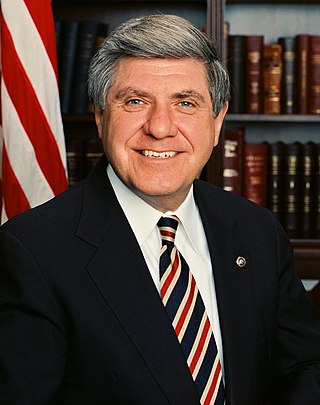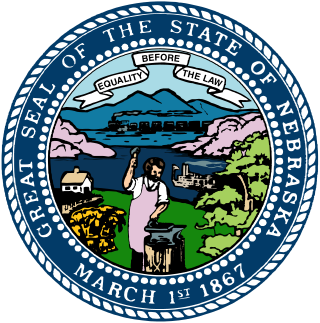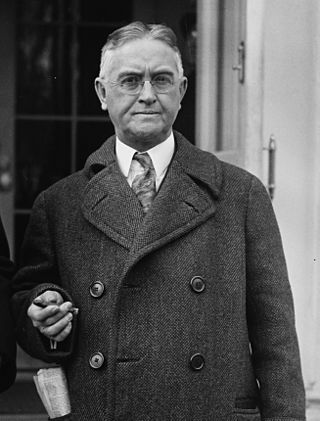
The 1908 United States presidential election was the 31st quadrennial presidential election, held on Tuesday, November 3, 1908. Republican Party nominee William Howard Taft defeated three-time Democratic nominee William Jennings Bryan.

The 1924 United States presidential election was the 35th quadrennial presidential election, held on Tuesday, November 4, 1924. In a three-way contest, incumbent Republican President Calvin Coolidge won election to a full term. Coolidge was the second vice president to ascend to the presidency and then win a full term.

William Jennings Bryan was an American lawyer, orator, and politician. Beginning in 1896, he emerged as a dominant force in the Democratic Party, running three times as the party's nominee for President of the United States in the 1896, 1900, and 1908 elections. He served in the House of Representatives from 1891 to 1895 and as the Secretary of State under Woodrow Wilson from 1913 to 1915. Because of his faith in the wisdom of the common people, Bryan was often called "the Great Commoner", and because of his rhetorical power and early fame as the youngest presidential candidate, "the Boy Orator".

The 1924 Democratic National Convention, held at the Madison Square Garden in New York City from June 24 to July 9, 1924, was the longest continuously running convention in United States political history. It took a record 103 ballots to nominate a presidential candidate. It was the first major party national convention that saw the name of a woman, Lena Springs, placed in nomination for vice president. John W. Davis, a dark horse, eventually won the presidential nomination on the 103rd ballot, a compromise candidate following a protracted convention fight between distant front-runners William Gibbs McAdoo and Al Smith.

Charles Wayland Bryan was an American businessman and politician who served as the 20th and 23rd Governor of Nebraska, and Mayor of Lincoln, Nebraska, and was the Democratic nominee for Vice President in 1924. He was the younger brother of Secretary of State William Jennings Bryan, who was the Democratic nominee for President in 1896, 1900, and 1908.

The 1924 Republican National Convention was held in Cleveland, Ohio, at the Public Auditorium, from June 10 to 12.

The Nebraska Democratic Party is the affiliate of the Democratic Party in the state of Nebraska. Over 700 Democrats are elected across the state of Nebraska. Jane Kleeb is the chair of the Nebraska Democratic Party and also serves as the Midwest Chair of the Association of State Democratic Committees.

The 1994 Nebraska gubernatorial election was held on November 8, 1994. Incumbent Democratic Governor Ben Nelson won a re-election to a second term in a landslide, defeating Republican businessman Gene Spence by 47.4 percentage points and sweeping all but two counties in the state. As of 2023, this is the last time that a Democrat was elected governor of Nebraska.

The 2014 Nebraska gubernatorial election took place on Tuesday, November 4, 2014, to elect the 40th Governor of Nebraska. Republican Candidate and former COO of TD Ameritrade Pete Ricketts defeated Democratic candidate and former Regent of the University of Nebraska Chuck Hassebrook, receiving 57.2% of the vote to Hassebrook's 39.2% This was the first open seat election, and the first time a Democrat won a county for governor since 1998.

A general election was held in the U.S. state of Nebraska on November 6, 2018. All of Nebraska's executive officers were up for election as well as a United States Senate seat, and all of Nebraska's three seats in the United States House of Representatives.

The 1926 Nebraska gubernatorial election was held on November 2, 1926, and featured incumbent Governor Adam McMullen, a Republican, narrowly defeating Democratic nominee, former Governor Charles W. Bryan, to win a second and final two-year term in office.

The 1922 Nebraska gubernatorial election was held on November 7, 1922, and featured former Mayor of Lincoln Charles W. Bryan, a Democrat, defeating Republican nominee, state Senator Charles H. Randall.

The 1918 Nebraska gubernatorial election was held on November 5, 1918, and featured former Lieutenant Governor Samuel R. McKelvie, a Republican, defeating incumbent Democratic Governor, Keith Neville.

The 1898 Nebraska gubernatorial election was held on November 8, 1898. Incumbent Populist Governor Silas A. Holcomb did not stand for re-election. Populist and Democratic fusion nominee William A. Poynter defeated Republican nominee Monroe Hayward with 50.19% of the vote.

The 2022 Vermont Senate election took place on November 8, 2022, as part of the biennial United States elections. The election coincided with elections for other offices including the U.S. Senate, U.S. House, Governor, and State House. Vermont voters elected all 30 state senators from 16 districts, with each district electing between one and three senators. State senators serve two-year terms in the Vermont Senate. Primary elections were held on August 9, 2022. This election will be the first to use new districts adopted by the Vermont General Assembly to allocate for population changes across the state after the 2020 census.

The 1946 Nebraska lieutenant gubernatorial election was held on November 5, 1946. Incumbent Nebraska Lieutenant Governor Roy W. Johnson lost to Robert B. Crosby in the Republican primaries after the Nebraska Republican Pre-Primary Convention refused to endorse him for reelection. Thus, the general election featured Robert B. Crosby as the Republican nominee who defeated Democratic nominee Robert J. Swanson.

The 1926 Nebraska lieutenant gubernatorial election was held on November 2, 1926, and featured incumbent Nebraska Lieutenant Governor George A. Williams, a Republican, defeating Democratic nominee Frank A. Dutton as well as Progressive nominee Lloyd H. Huffman.

The 1924 Nebraska lieutenant gubernatorial election was held on November 4, 1924, and featured Republican nominee George A. Williams defeating Democratic nominee P. J. Mullin as well as Progressive nominee Granville Hummer and Prohibition nominee J. F. Webster. Incumbent Nebraska Lieutenant Governor Fred G. Johnson, a Republican, chose not to seek reelection to the office of lieutenant governor in order to challenge George W. Norris for the Republican nomination for US Senate from Nebraska.

The 1922 Nebraska lieutenant gubernatorial election was held on November 7, 1922, and featured Republican nominee Fred G. Johnson defeating Democratic nominee P. J. Mullin as well as Progressive nominee T. J. Ellsberry. Incumbent Nebraska Lieutenant Governor Pelham A. Barrows, a Republican, chose not to seek reelection to the office of lieutenant governor in order to run for the vacant seat of C. Frank Reavis, former US Representative from Nebraska's 1st congressional district. Barrows was unsuccessful at obtaining the Republican nomination.

The 1918 Nebraska lieutenant gubernatorial election was held on November 5, 1918, and featured Republican nominee Pelham A. Barrows defeating Democratic nominee William B. Banning as well as Prohibition Party nominee David B. Gilbert. Incumbent Nebraska Lieutenant Governor Edgar Howard decided not to seek reelection to the office of lieutenant governor in order to run for US Senate, but he was defeated in the Democratic primaries by John H. Morehead.






















